#Las Calatravas Church
Text
King Felipe VI, Queen Letizia, Princess Leonor, and Infanta Sofía attend the procession of El Encuentro at Las Calatravas Church in Madrid on 30 March 2024.
The image of the royal family actively participating in the religious celebration did not go unnoticed by those present or the media, highlighting the gesture of closeness and commitment of the monarchy to the traditions and culture of the country.
🎥: EUROPA PRESS
#King Felipe VI#Queen Letizia#Princess Leonor#Infanta Sofía#Spanish Royal Family#El Encuentro#Las Calatravas Church#Easter Sunday#Holy Week#Holy Week 2024#Easter 2024#Lenten Season#House of Bourbon#Princess of Asturias
8 notes
·
View notes
Photo
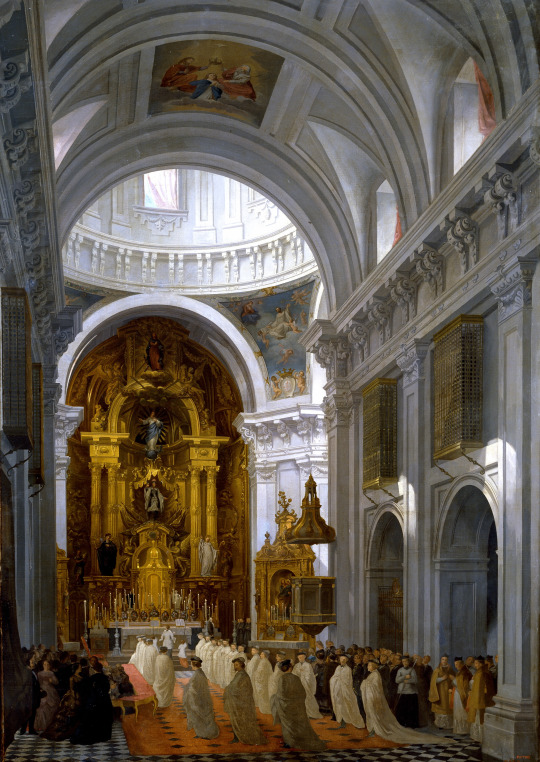
Francisco Hernández Tomé (Spanish, c.1856-1872)
Interior de la Iglesia de las Calatravas, en Madrid
#Francisco Hernández Tomé#spanish art#spanish#art#spain#classical art#Interior de la Iglesia de las Calatravas#christian art#european art#christian#christianity#Christendom#christentum#fine art#beautiful art#interior of a church#procession#oil painting
156 notes
·
View notes
Text



King Felipe VI of Spain, Queen Letizia of Spain, Princess Leonor, The Princess of Asturias and Infanta Sofía of Spain attend the procession of El Encuentro at Las Calatravas Church in Madrid, Spain -March 30th 2024.
#king felipe#king felipe vi#queen letizia#princess leonor#princess of asturias#infanta sofia#spanish royal family#spain#2024#march 2024#procession of el encuentro#procession of el encuentro 2024#easter#easter 2024#royal children#my edit
33 notes
·
View notes
Text






Spanish royal ladies at the "Procesion del Encuentro" during Holy Week at the Church of las Calatravas in Madrid - 30.03.24
17 notes
·
View notes
Photo
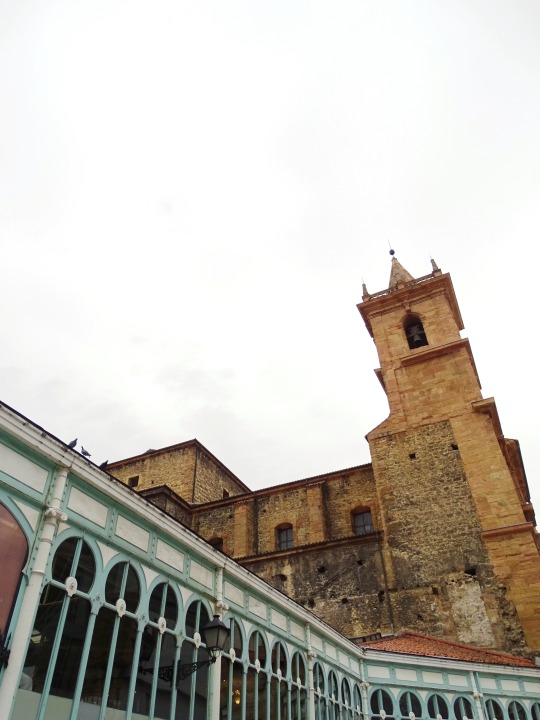
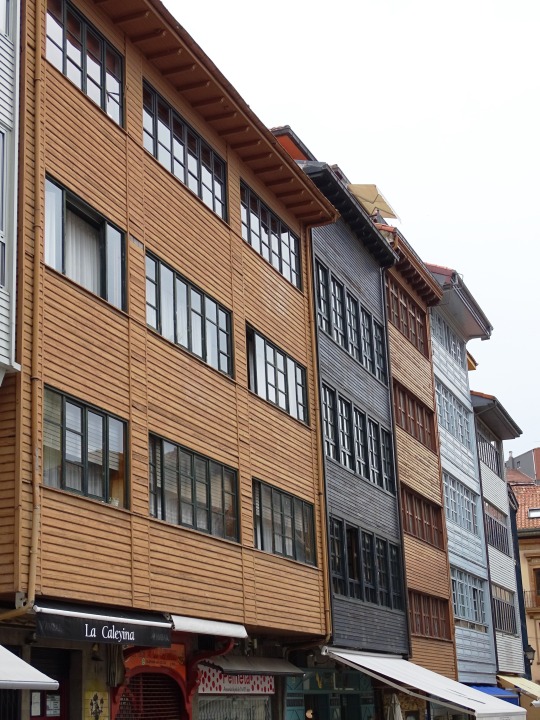


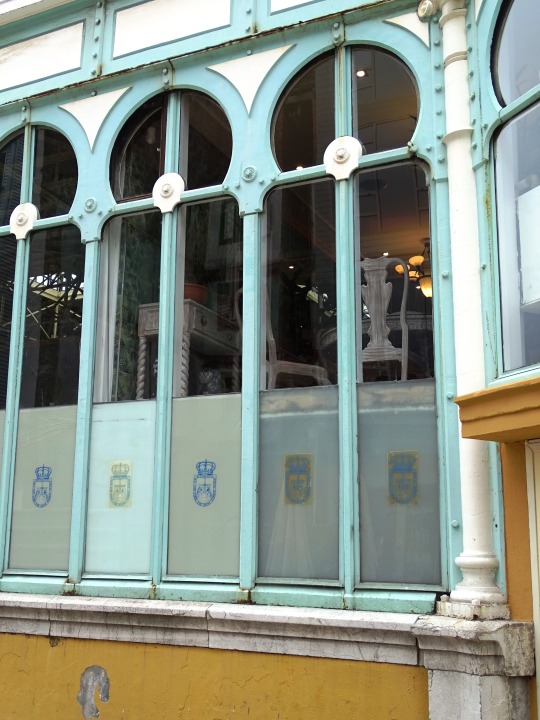
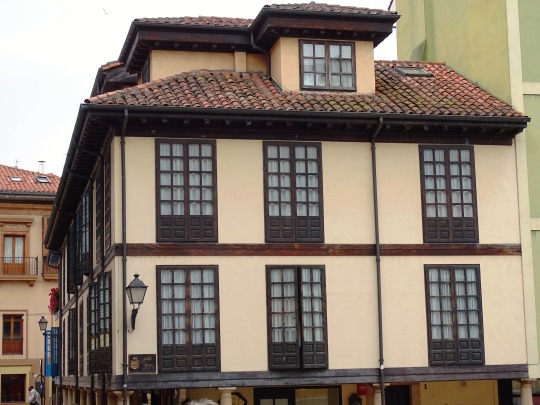
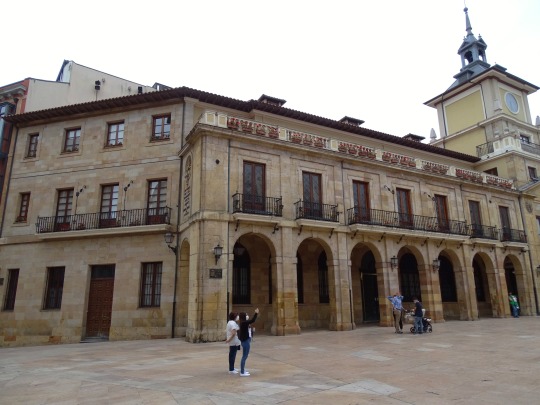

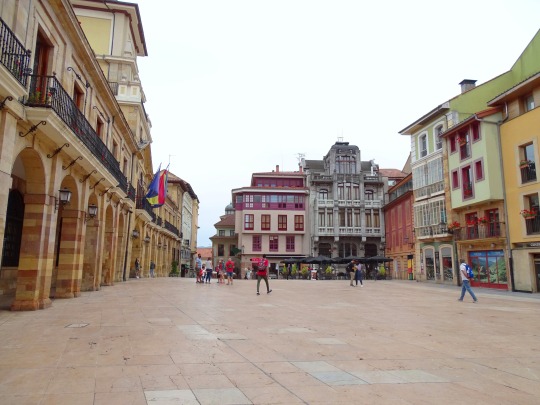
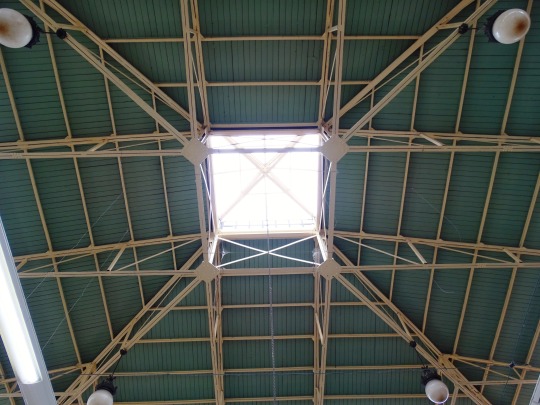
Plaza de la Constitución, Oviedo (No. 2)
El Fontán Market (17th-18th centuries). A simple but rather monumental complex; an 18th-century porticoed square, which housed the vegetable market. It fell victim to speculative manoeuvres. It was left to deteriorate on its own; claiming that it was beyond repair, it was then demolished in 1998 and rebuilt offering all modern amenities, but with its original proportions radically changed; the original complex being much lower than its modern replacement. Casas del Cuitu, early 20th century Art Nouveau apartment building.
Palacio de Congresos de Oviedo projected by Santiago Calatrava.
Church of San Tirso, or the Church of Saint Thyrsus, is located south west of the main cathedral. Only the east end of the church can trace its roots to Alfonso II's reign, with the rest of the church created during the 14th century. The triple arcaded window and east wall are the only portions of the church made during the early 9th century.
Camposagrado Palace built in 1728 and 1744 combining baroque and neo-classical architectures. It is presently the home of the Regional Court of Asturias.
Source: Wikipedia
#Iglesia de San Isidoro el Real#Plaza de la Constitución#Oviedo#Uviéu#Asturias#original photography#town hall#old town#city hall#España#Spain#Northern Spain#Southern Europe#summer 2021#Mercado El Fontán#square#architecture#tourist attraction#landmark#travel#vacation#interior#exterior
4 notes
·
View notes
Text
L'Oculus à New York y êtes-vous déjà allé ?
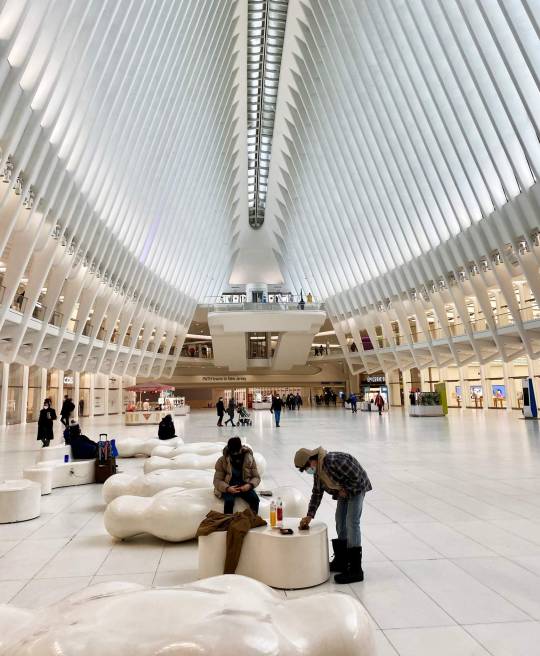
Au pied de la tour One World Trade Center, la nouvelle gare du World Trade Center mérite elle aussi la visite ! Découvrez l'Oculus, la gare la plus futuriste de New York.

L'Oculus et le mémorial du 11 septembre 2001
Ce qu’il faut savoir sur l’Oculus entre la tour One World Trade Center et le musée du 11 septembre 2001, impossible de manquer l’Oculus, un grand bâtiment blanc en forme d’ailes d’oiseau. L’Oculus abrite le WTC Transportation Hub, la gare du World Trade Center d’où partent les trains PATH vers le New Jersey. L’Oculus remplace l’ancienne gare PATH, détruite lors des attentats du 11 septembre 2001 et l’effondrement des tours du World Trade Center. Il aura fallu plus de 10 ans pour mener à bien cette construction. Le projet a été lancé en 2004 et la nouvelle gare a été inaugurée en mars 2016. Montant total des travaux près de 4 milliards de dollars ! L’ensemble a été dessiné par l’architecte espagnol Santiago Calatrava. Cet architecte est aussi l’auteur de la gare TGV Saint-Exupéry à Lyon et de la gare Liège-Guillemins. Vous trouverez d’ailleurs un curieux air de famille entre les 3 gares !
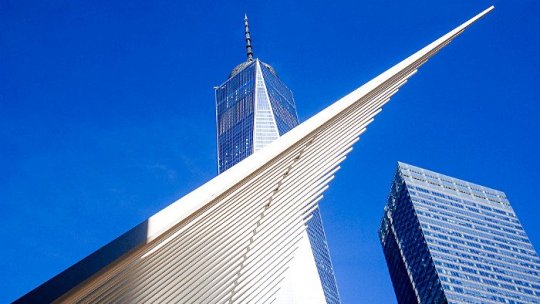
L’Oculus et la tour One World Trade Center
Que voir dans l’Oculus ?Pour en prendre plein la vue, accéder à l’Oculus par l’entrée située sur Church Street, face à Dey Street. Vous serez alors directement dans le vif du sujet avec une vue sur l’immense atrium. En arrivant par cette entrée, vous profiterez d’une perspective originale sur la tour One World Trade Center. Prenez ensuite les escalators ou les escaliers pour descendre dans l’atrium central. Cet espace ovale mesure 111 mètres de long et il est chapeauté par une impressionnante verrière. Tout autour de l’esplanade centrale et dans les galeries attenantes, le complexe abrite un grand centre commercial, le Westfield World Trade Center, ouvert de 10h à 19h. Parmi les boutiques Apple, Banana Republic, Bose, Christian Dior, H&M, Samsonite, Hugo Boss, Lacoste, L’Occitane, les parfums Sephora, les montres Swatch, le marchand de vins Pure Liquid ou encore la lingerie Victoria’s Secret. Si vous avez une petite faim, vous trouverez les chaînes Prêt à Manger, Starbucks et Shake Shack. En poursuivant par la galerie qui mène au World Trade Center, vous déboucherez sur l’entrée de la gare proprement dite, avec accès aux quais du PATH. La MetroCard et les titres de transports de New York ne sont pas valables pour prendre les trains en direction du New Jersey. Si vous voulez faire une petite escapade dans le New Jersey, notamment à Paulus Hook pour admirer la vue sur la skyline de New York, vous devez prendre un ticket aux bornes automatiques. Prix de l’aller simple 2,75 $
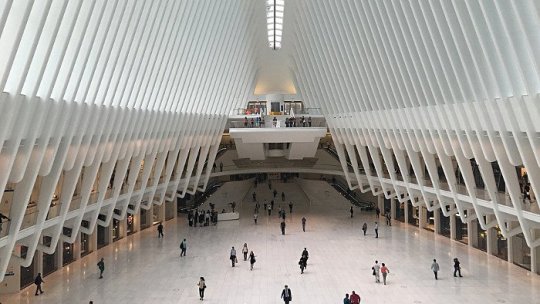
L'atrium central
7 notes
·
View notes
Photo


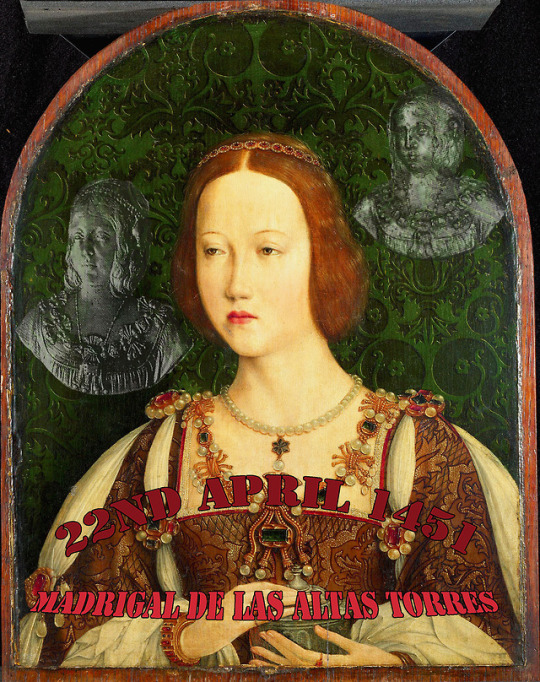


Isabella of Castile, the Catholic, was born on April 22nd in 1451, on Maundy Thursday, at the so-called royal palace of the village of Madrigal, called de las Altas Torres. At the moment the most important source about the birth is the letter sent by John II to the city of Segovia, on April 26th, 1451, informing them of such happy event:
’I let you know that, by the grace of our Lord, past Thursday the Queen doña Isabel, my very dear and very beloved wife, gave birth to an infanta, which I let you know so you would give many thanks to God for the liberation of the said Queen, my wife, and for the birth of the said infanta, because of which I ordered Johan de Busto to go to you, who carries the present.’
That <<past Thursday>> coincided with Maundy Thursday hence could not be more important in religious Christian life, and she took responsibility to celebrate it during her whole life with her family and with her court. The chronicler Doctor Toledo will specify that she was born in Madrigal, on Thursday, on April 22nd, at 4:30 pm. Thanks to both sources, we have established the day and hour of birth.
The same can be said about the birthplace, the cradle of the future Queen. It was at the royal palace of Madrigal, not a monumental building which was not for these places of residence, but a temporal residence in the itinerant life of the king and the court. Thus, its simplicity is understandable and its austere mudejár style can be recorded. It seems that house captivated the Portuguese (Isabella’s mother). The palace and the entire village were hers. She would go there to take refuge during decades, when her psychosis intensified, and there she would pass away.
The newborn was not fed by her mother; it’s certain that Isabella’s wet-nurse was María López, wife of Juan de Molina, whom the queen will recall on March 3, 1495, granting her 10.000 maravedíes <<because the said María López gave her Highness her milk>>. This fact appears in las Cuentas (household accounts) and is indubitable.
- “Isabel la Católica: vida y reinado”, Tarsicio de Azcona
Isabel was born far inland, behind the lofty walls of Madrigal de las Altas Torres—Madrigal of the High Towers—in the heart of the meseta, the flat tableland at the heart of Castile. The forty-eight altas torres rising along the forty-foot-high walls ringing the town spoke of safety in a world geared to war, particularly war between Christian inhabitants and Muslim raiders. But those walls also spoke of paradox: made of brick and rubble, materials typical to mudéjar construction, they revealed an origin or an inspiration unequivocably Arabic. Madrigal, like other places on Spain’s central plateau, had been alternately occupied by Christians and Muslims until well into the eleventh century, and it was home to some inhabitants of Muslim culture afterward. In Madrigal too, in the great house abutting those walls called the royal palace, Isabel toddled under intricately worked wooden ceilings, artesonados, carved by mudéjares, Muslim subjects of Castile’s king. And tradition has it that she was baptized in Madrigal’s church of San Nicolás, in its baptismal font thickly encrusted with gold from Muslim Africa.
Only an occasional reference sheds light on Isabel’s childhood. At seventeen, she wrote to her half-brother, the king Enrique IV, accusing him of having treated her badly, representing herself as a semi-orphan raised in obscurity and kept in want by him. Her court chronicler, Hernando del Pulgar, was to state that her early years were spent ‘in extreme lack of necessary things,’ and that she was without a father and ‘we can even say a mother.’
Isabel was three when her father, Juan II of Castile, died. He had doted on her mother, Isabel of Portugal, his young second wife, and, rumor had it, come to resent the control exerted over him by his longtime mentor, Alvaro de Luna, who sought to regulate the king’s conjugal visits to his queen. What is indisputable is that shortly after Isabel’s birth, Luna was beheaded at Juan’s order. Within a year, Juan, whether through regret or because Luna’s restraining hand was gone, grew immoderate, it was said, in the pleasures of love and table, fell ill of quartanary fevers, and although believing prophecies that he would live to be ninety, died on July 21,1454, and the crown passed to his elder son, Enrique. Juan was forty-nine years old, the longest-lived king of his dynasty in five generations.
Enrique IV was then thirty. He had had no children with his first wife, Blanca of Navarre, and his second, Juana of Portugal, would have none until Isabel was ten; until then Isabel grew up seeing her younger brother, Alfonso—born in November 1453 when she was two—as heir apparent to Castile’s crown and herself as second in line, as her father’s last will had stipulated. To the childless Enrique, the two children represented family and dynastic continuity, but also a potential threat. As for Isabel, after the death of her father, her circumstances were none too secure on several other counts she did not mention in that letter.
Her mother, the young dowager queen, Isabel of Portugal, who was twenty-seven years old at her husband’s death, then took the two children to live in Arévalo, a royal town consigned to her in Juan’s will. Shortly thereafter, according to the chronicler Alonso de Palencia, Enrique called on her accompanied by a favorite of his, Pedro Girón, the master of the military order of Calatrava; Girón immediately ‘made some indecent suggestions’ that shocked the recent widow. Palencia, who is generally vitriolic about both Enrique and Girón, went on to assert that the importuning by this overhasty, unwelcome (and, patently, not sufficiently noble) suitor threw Isabel of Portugal into a profound sadness and horror of the outside world, that she then ‘closed herself into a dark room, self-condemned to silence, and dominated by such depression that it degenerated into a form of madness.’
Another chronicler, who was more in touch with events at the time, confirms the reclusiveness of Isabel’s mother but dates it earlier, from her daughter’s birth. Whatever the cause or date, young Isabel grew up with a deeply disturbed mother. The child may well have dreaded becoming like her, and suffered tension between affection and fear. Surely too she was aware that her own birth was among the causes mentioned for her mother’s madness. It is tempting to conjecture that qualities that Isabel displayed as an adult—love of order and the striving for it; a no-nonsense, highly rational stance; and a sharply defined personality, were honed in reaction to her mother’s condition, and even to think that her desire for light in all its forms, and especially in its religious associations—her abhorrence of the forces of darkness, her determination to cleanse the body politic of impurities—was not unrelated to the circumstances of her childhood.
Isabel grew up, then, in several sorts of obscurity, her childhood a sort of purgatory and a test of moral fiber she passed magnificently. Such was long the accepted version of her early years; it was her own version. It is neither strictly accurate nor complete.
Arévalo, fifteen miles from Madrigal and like it a market town, is remembered as the best fortified of royal towns. There, her mother’s condition notwithstanding, Isabel spent her early years in great stability and familial warmth. For when she was two and her mother again pregnant, her widowed grandmother, Isabel de Barcelos, arrived from Portugal. Tellingly, when first mentioned in the chronicles Isabel de Barcelos is in her forties and sitting, at King Juan’s request, in his privy council. Contemporaries, among them the chronicler Diego de Valera, recognized in her ‘a notable woman of great counsel.’ Valera affirmed that after the death of the king, Isabel de Barcelos ‘was of great help and consolation to the widowed queen, her daughter’; and he commented that her death, in 1466, ‘was very harmful.’ Pulgar adds that Isabel missed her grandmother sorely. Surely Isabel de Barcelos ran her daughter’s household. And she it doubtlessly was whom the child Isabel took as model. It is revealing that later, as queen, Isabel of Castile enjoyed keeping about her elderly women of good repute and good family.
From all accounts, Isabel de Barcelos was a formidable lady of formidable lineage. She came of royal Portuguese stock with a history of going for the throne and of doing it with claims far weaker than would be those of her Castilian grandchild. Daughter of the first duke of Braganza, Portugal’s most powerful noble and an illegitimate son of the king, Joāo I, she had married her uncle, Prince Joāo, one of five sons Joāo I had with Philippa, his queen consort. Philippa too came of redoubtable stock. Her father was John of Gaunt, the English king-making duke of Lancaster, and her mother, Costanza, was a Castilian infanta. This lineage meant that young Isabel carried in her veins the royal blood of Castile, Portugal, and England. Doubtlessly too, she took dynastic pride in her own name, Isabel, repeated through seven generations of royal women and originating in her ancestor Saint Isabel, the thirteenth-century Portuguese queen canonized for her good works and miracles.
Isabel’s aya, or nurse-governess, in Arévalo was also Portuguese. She was Clara Alvarnáez, married to Gonzalo Chacón, to whom Juan II had consigned his children’s education. Chacón was also the dowager queen’s camerero, the administrator of her household. Oddly enough, Chacón had earlier filled the same post for Álvaro de Luna, Juan II’s former favorite. Even so, Chacón and Clara Alvarnáez remained close to Isabel throughout their lifetimes.
- „Isabel the Queen: Life and Times”, Peggy K. Liss
93 notes
·
View notes
Note
Hello there! :D I'm a huge fan of mythologies from various different cultures, so I was wondering if you could tell a bit about Spanish mythology? Anything from mythical creatures to popular legends. Thank you in advance! ^^
SPANISH LEGENDS AND MYTHOLOGY
Hello! Sorry for taking so long to answer. Unfortunately, this theme is not my specialty at all, but I’ll try my best to give you a decent answer :’D
PRE-ROMAN IBERIANS

Little is known about Iberian customs and beliefs. They had a very rich and flourishing culture and social life, but all the written testimony had been lost due to the fact that their writing has not bee de-codified yet. Apparently they were polytheists and, according to the late chronicles of roman historians during the invasion, had received a lot of religious influence from Phoenicians and Greeks, their permanent trade partners for centuries. There had been some discoveries like The Lady of Baza and the Lady of Elche that suggest a strong leadership by Priestesses in the religious life.
As for mythology, it had been heavily inspired by the Helenic beliefs about this part of the world. According to Carthaginian chronicles there used to be a temple where the “Columns of Heracles” were supposed to be, at the edge of the Strait of Gibraltar. Hannibal Barca is said to have sworn eternal hate to Rome in that temple. One of the theories also say that he gave name to the city of Barcelona and the Columns of Heracles are still present in the Spanish Crest of Arms.
Still, most of the known Iberian mythology is like: “here supposedly be a rock where something happened according to other people.”
A myth/legend/weird history thing worth mentioning though is Tartessos:
TARTESSOS
Tartessos is, crudely said, the Iberian Atlantis. Although to be fair Atlantis was probably made up by Plato but Tartessos has been definitively proven to have been real in the recent research. The problem is that nobody knows where the heck it was.
Supposedly it was a great coastline civilization miles ahead of its surrounding regions and of their time, with a rich culture and technology, that just disappeared without leaving any trace. It’s fall is mostly consistent with the fall of Phoenicia, around the Vth century BC.
Some theories say that Tartessos had been wiped out by a Tsunami, since its a region of heavy seismic activity, others that it just died out with the end of the Phoenician commerce or that the surrounding cultures caught up and they stopped being special, thus just mixing around and disappearing.
In any case, it’s a mystery!
THE CELTIC NORTH-WEST
Their legends and mythology are far clearer, more documented, and survive to this day. However, I don’t think I can surprise you with any of them because (according to my tour guide in Santiago) most of them can be found in other regions of Celtic descend, specially in Ireland.
Of the most “recent” (middle ages) The Holy Procession (the procession of the dead dressed in white that you can find walking around at midnight) comes to mind, also the meigas, sort of witches, and bruixas, their nice, cool equivalent that people liked.
St. JAMES THE MOOR-SLAYER

This is an individual legend but it’s very important. So, in Galicia they say rest the bones of the Apostle St. James (Santiago), which turned it into the hotspot for pilgrimage, specially after the Muslims in the east cut the christian pilgrimage routes to Jerusalem and started killing the pilgrims. So like, the next best option, and way safer, was the restplace of St. James, crossing the territories of the Catholic Kingdoms of Hispania.
PS: Leaving aside the fascinating legend of how his rests got there (it involves a stone boat, a couple of bulls and a truckload of scallops), the first touristic-guide in the world is believed to be a guide to the way of St. James, the Codex Calixtinus, written around the year 1135.
According to the Legend, the Asturian King Ramiro I was visited by the Apostle Santiago clad in battle wear the night before a big battle with the moors, and the next day, at the battlecry of “Santiago!” the troops of Ramiro won a seemingly impossible battle. From then on and through the centuries variations of “For Spain and for Santiago!” (Santiago and charge, Spain!, For Santiago and the Spains!, etc…) became the official cry of the Spanish Army and the apostle Santiago is the patron Saint of Spain.
PS: Around the same period we also find a lot of legends and lore related to the Templars and the military orders of the Peninsula (Santiago, Calatrava, Alcántara, Montesa in Spain and Avis in Portugal)
THE LOVERS OF TERUEL

Sometimes called “the Spanish Romeo & Juliet” it’s in my opinion a way better story, not only it has been proven to have elements of truth in it, but because nobody is fucking 13!
Funnily enough for a short while this legend had been accused of being a copy of one included in the Decameron of Boccaccio until it had been discovered that the first instances of it date back to a whole century before the Decameron was written, so it may have been actually the other way ‘round.
Anyway, the events were supposed to have happened in the city of Teruel in the year 1217. A young boy Diego (sometimes called Juan) of the Marcilla family and the girl Isabel of the Segura family, grew up playing together and when their teenage hormones hit hard, fell in love.
However, even though the Marcilla family was important, it was not as important as the Segura family and Diego was the second son, meant to inherit nothing. There was no way he could marry the only daughter and heiress of the Segura family. So he struck a deal with her father: he’d go to war (meaning la Reconquista) fight hard, rise in rank and earn a world of wealth in five years. If in that time he returned rich, he’d marry Isabel.
So he left. Passed some years, Isabel’s father started insisting in her to get married but, and here comes my favorite part, she refused on the premise that she had to remain a maiden until 20, because no woman should get married before she learned how to manage a household. And her father, as any good middle-ages dad, that loved and respected his daughter, agreed with her.
However, when the five years passed and Diego didn’t return, Isabel believed him dead and agreed to marry Don Pedro of Azagra. However, right after the ceremony, Diego returned with great riches! Too late tho. His beloved was already married.
So he sneaked up into her and her husband’s bedroom at night and asked her for a kiss: “kiss me, for I’m dying!”. She refused on the terms that she would not be unfaithful to her husband, he asked her again and she refused again.
So Diego just dropped dead of heartache.
Isabel woke up her husband and told him what happened. He was like “but why didn’t you kiss him?!” so she told him she hadn’t wanted to betray her husband, so he was “you truly are a woman worth of praise.”
They sneaked him out of their home in the middle of the night and left him in a local church, so the husband wouldn’t get blamed for his death.
The next day the funeral ceremony took place and Isabel came, dressed in her wedding gown, and leaning over Diego’s body gave him the kiss that she had refused him in life.
And then she also fell dead.
The husband then told everyone in the church their story and the town agreed to bury them together, so at least in death they would be side by side.
Their inexplicably mummified bodies were discovered in 1555 during repair works at the San Pedro church, in Teruel, next to a document dating to the formerly stated year, corroborating the popular legend.
Since with time the fame of this story spread around Spain. The mummies now lay in a chapel and in marble tombs with exquisitely sculpted lids by the artist Juan de Ávalos y Taborda.


Written as a part of the @aphaskevent
Country embassy: Spain (in case it wasn’t clear… xD)
Sorry for not being able to tell any better stories, and this probably doesn’t answer your question, but I just thought it better not to talk too much on stuff I didn’t know about and focus on what I did.
#hetaliafandomhub#aphaskevent#aph spain#spain#spanish mythology#aph#aph ambassador#embassy board#kimanda#answers#pictures from wikimedia
64 notes
·
View notes
Photo
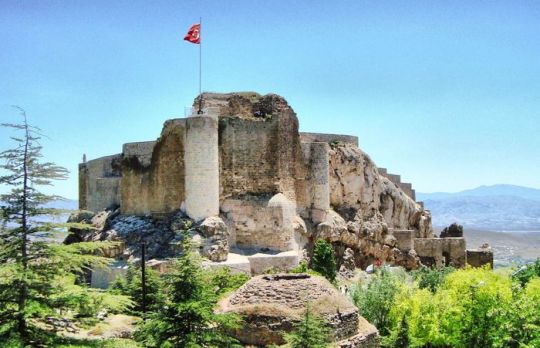
The History Of Harput
Centrally located in eastern Anatolia, Elazig promises visitors a rich feast of history and culture.
Dating back to the 3rd millennium B.C., Harput was home to numerous tribes from the Hurrians to the Seljuks. The castle at Harput, where legend has it that milk was used to alleviate a water shortage during the construction, has ensured regional security since the time of the Urartus.
Made by sculptor Nurettin Orhan, the monument to Belek Gazi, a key figure in Harput’s history, in the courtyard of the Great Mosque is a reminder of this important ruler.
Dabakhane River to the north of Harput Castle is rich in minerals. Boasting thermal properties, its waters are highly recommended for gastrointestinal and liver ailments as well as for depression.
Turkey’s second largest dam reservoir, Keban Dam not only supplies a major portion of the country’s power needs, it has also brought the local people resort areas where they can enjoy freshwater fish.
Elazig Archaeology and Ethnography Museum is located on the campus of Firat University School of Engineering. The museum, which reflects the region’s archaeological wealth, features exhibits of finds unearthed in archaeological excavations in the area around Keban Dam Reservoir as well as examples of the region k ethnographical richness. Closed Mondays, the museum is open other days 8 a.m. to 5p.m.
Young at heart
With its orange- scented coasts, Wild festivals and architectural wonders, valencia is spain’s forever- young city bythe sea. And it’s poised now to becomethe mediterranean’s new star. Here are five reasons to see valencia.
City of art and learning
With its vast squares and modern architecture, this is perhaps the city’s most striking quarter. In addition to Oceanographic, one of Europe’s largest aquariums, the Cuidad de las Artes y las Ciencias with its museum, cinema and opera draws upwards of five million visitors annually. And the area’s fantastic architecture bears the signature of native son Santiago Calatrava.
The silk market
Near the Plaza de la Reina where the cathedral stands, one of the city’s iconic structures with its gothic lines and octagonal bell tower, there is another interesting building, the historic 15th century Lonja de la Seda, or silk market. Declared a world cultural heritage by UNESCO, it is surrounded by historic churches and other buildings.
Albufera lagoon
This lagoon in Albufera Nature Park is 11 kilometers south of Valencia. A wetland protected as one of the Mediterranean’s unique biological reserves, it is fed by natural underwater springs. A boat tour at sunset on the lake, which is a center of attraction for bird watchers, is another Valencia pleasure.
Benicassim festival
One of the world’s leading open-air music festivals, Benicassim is gearing up for this summer with the slogan, “Four days of concerts, eights days of camp, 100 artists and more (short films, theater, art, dance and courses). The big guns of this year’s festival,
July 14-17, include Arcade Fire, Arctic Monkeys, Mumford & Sons, Portishead and The Strokes,
Barrio de carmen
A leisurely stroll down the Barrio de Carmen, the city’s eating, drinking and entertainment district, is de rigueur for getting to know Valencia. The wind-swept streets lined with century-old buildings will let you feel the heartbeat of the everyday life unique to this part of town.
You can also sample here the Spanish snacks known as tapas to the accompaniment of live Flamenco music.
S: https://travel.doturkey.com/harput/
0 notes
Photo
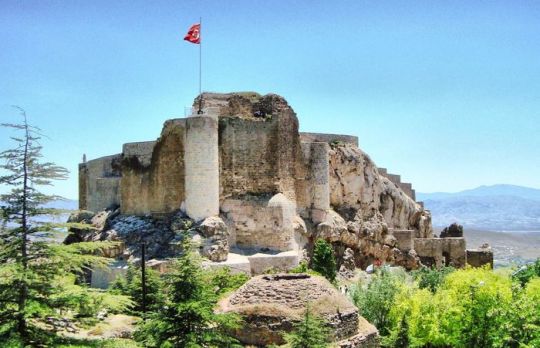
The History Of Harput
Centrally located in eastern Anatolia, Elazig promises visitors a rich feast of history and culture.
Dating back to the 3rd millennium B.C., Harput was home to numerous tribes from the Hurrians to the Seljuks. The castle at Harput, where legend has it that milk was used to alleviate a water shortage during the construction, has ensured regional security since the time of the Urartus.
Made by sculptor Nurettin Orhan, the monument to Belek Gazi, a key figure in Harput’s history, in the courtyard of the Great Mosque is a reminder of this important ruler.
Dabakhane River to the north of Harput Castle is rich in minerals. Boasting thermal properties, its waters are highly recommended for gastrointestinal and liver ailments as well as for depression.
Turkey’s second largest dam reservoir, Keban Dam not only supplies a major portion of the country’s power needs, it has also brought the local people resort areas where they can enjoy freshwater fish.
Elazig Archaeology and Ethnography Museum is located on the campus of Firat University School of Engineering. The museum, which reflects the region’s archaeological wealth, features exhibits of finds unearthed in archaeological excavations in the area around Keban Dam Reservoir as well as examples of the region k ethnographical richness. Closed Mondays, the museum is open other days 8 a.m. to 5p.m.
Young at heart
With its orange- scented coasts, Wild festivals and architectural wonders, valencia is spain’s forever- young city bythe sea. And it’s poised now to becomethe mediterranean’s new star. Here are five reasons to see valencia.
City of art and learning
With its vast squares and modern architecture, this is perhaps the city’s most striking quarter. In addition to Oceanographic, one of Europe’s largest aquariums, the Cuidad de las Artes y las Ciencias with its museum, cinema and opera draws upwards of five million visitors annually. And the area’s fantastic architecture bears the signature of native son Santiago Calatrava.
The silk market
Near the Plaza de la Reina where the cathedral stands, one of the city’s iconic structures with its gothic lines and octagonal bell tower, there is another interesting building, the historic 15th century Lonja de la Seda, or silk market. Declared a world cultural heritage by UNESCO, it is surrounded by historic churches and other buildings.
Albufera lagoon
This lagoon in Albufera Nature Park is 11 kilometers south of Valencia. A wetland protected as one of the Mediterranean’s unique biological reserves, it is fed by natural underwater springs. A boat tour at sunset on the lake, which is a center of attraction for bird watchers, is another Valencia pleasure.
Benicassim festival
One of the world’s leading open-air music festivals, Benicassim is gearing up for this summer with the slogan, “Four days of concerts, eights days of camp, 100 artists and more (short films, theater, art, dance and courses). The big guns of this year’s festival,
July 14-17, include Arcade Fire, Arctic Monkeys, Mumford & Sons, Portishead and The Strokes,
Barrio de carmen
A leisurely stroll down the Barrio de Carmen, the city’s eating, drinking and entertainment district, is de rigueur for getting to know Valencia. The wind-swept streets lined with century-old buildings will let you feel the heartbeat of the everyday life unique to this part of town.
You can also sample here the Spanish snacks known as tapas to the accompaniment of live Flamenco music.
S: https://travel.doturkey.com/harput/
0 notes
Photo

Harput
Centrally located in eastern Anatolia, Elazig promises visitors a rich feast of history and culture.
Dating back to the 3rd millennium B.C., Harput was home to numerous tribes from the Hurrians to the Seljuks. The castle at Harput, where legend has it that milk was used to alleviate a water shortage during the construction, has ensured regional security since the time of the Urartus.
Made by sculptor Nurettin Orhan, the monument to Belek Gazi, a key figure in Harput’s history, in the courtyard of the Great Mosque is a reminder of this important ruler.
Dabakhane River to the north of Harput Castle is rich in minerals. Boasting thermal properties, its waters are highly recommended for gastrointestinal and liver ailments as well as for depression.
Turkey’s second largest dam reservoir, Keban Dam not only supplies a major portion of the country’s power needs, it has also brought the local people resort areas where they can enjoy freshwater fish.
Elazig Archaeology and Ethnography Museum is located on the campus of Firat University School of Engineering. The museum, which reflects the region’s archaeological wealth, features exhibits of finds unearthed in archaeological excavations in the area around Keban Dam Reservoir as well as examples of the region k ethnographical richness. Closed Mondays, the museum is open other days 8 a.m. to 5p.m.
Young at heart
With its orange- scented coasts,
Wild festivals and architectural wonders, valencia is spain’s forever- young city bythe sea. And it’s poised now to becomethe mediterranean’s new star. Here are five reasons to see valencia.
City of art and learning
With its vast squares and modern architecture, this is perhaps the city’s most striking quarter. In addition to Oceanographic, one of Europe’s largest aquariums, the Cuidad de las Artes y las Ciencias with its museum, cinema and opera draws upwards of five million visitors annually. And the area’s fantastic architecture bears the signature of native son Santiago Calatrava.
The silk market
Near the Plaza de la Reina where the cathedral stands, one of the city’s iconic structures with its gothic lines and octagonal bell tower, there is another interesting building, the historic 15th century Lonja de la Seda, or silk market. Declared a world cultural heritage by UNESCO, it is surrounded by historic churches and other buildings.
Albufera lagoon
This lagoon in Albufera Nature Park is 11 kilometers south of Valencia. A wetland protected as one of the Mediterranean’s unique biological reserves, it is fed by natural underwater springs. A boat tour at sunset on the lake, which is a center of attraction for bird watchers, is another Valencia pleasure.
Benicassim festival
One of the world’s leading open-air music festivals, Benicassim is gearing up for this summer with the slogan, “Four days of concerts, eights days of camp, 100 artists and more (short films, theater, art, dance and courses). The big guns of this year’s festival,
July 14-17, include Arcade Fire, Arctic Monkeys, Mumford & Sons, Portishead and The Strokes,
Barrio de carmen
A leisurely stroll down the Barrio de Carmen, the city’s eating, drinking and entertainment district, is de rigueur for getting to know Valencia. The wind-swept streets lined with century-old buildings will let you feel the heartbeat of the everyday life unique to this part of town.
You can also sample here the Spanish snacks known as tapas to the accompaniment of live Flamenco music.
Source: https://tour.ephesusday.com/harput/
0 notes
Photo

Harput
Centrally located in eastern Anatolia, Elazig promises visitors a rich feast of history and culture.
Dating back to the 3rd millennium B.C., Harput was home to numerous tribes from the Hurrians to the Seljuks. The castle at Harput, where legend has it that milk was used to alleviate a water shortage during the construction, has ensured regional security since the time of the Urartus.
Made by sculptor Nurettin Orhan, the monument to Belek Gazi, a key figure in Harput’s history, in the courtyard of the Great Mosque is a reminder of this important ruler.
Dabakhane River to the north of Harput Castle is rich in minerals. Boasting thermal properties, its waters are highly recommended for gastrointestinal and liver ailments as well as for depression.
Turkey’s second largest dam reservoir, Keban Dam not only supplies a major portion of the country’s power needs, it has also brought the local people resort areas where they can enjoy freshwater fish.
Elazig Archaeology and Ethnography Museum is located on the campus of Firat University School of Engineering. The museum, which reflects the region’s archaeological wealth, features exhibits of finds unearthed in archaeological excavations in the area around Keban Dam Reservoir as well as examples of the region k ethnographical richness. Closed Mondays, the museum is open other days 8 a.m. to 5p.m.
Young at heart
With its orange- scented coasts,
Wild festivals and architectural wonders, valencia is spain’s forever- young city bythe sea. And it’s poised now to becomethe mediterranean’s new star. Here are five reasons to see valencia.
City of art and learning
With its vast squares and modern architecture, this is perhaps the city’s most striking quarter. In addition to Oceanographic, one of Europe’s largest aquariums, the Cuidad de las Artes y las Ciencias with its museum, cinema and opera draws upwards of five million visitors annually. And the area’s fantastic architecture bears the signature of native son Santiago Calatrava.
The silk market
Near the Plaza de la Reina where the cathedral stands, one of the city’s iconic structures with its gothic lines and octagonal bell tower, there is another interesting building, the historic 15th century Lonja de la Seda, or silk market. Declared a world cultural heritage by UNESCO, it is surrounded by historic churches and other buildings.
Albufera lagoon
This lagoon in Albufera Nature Park is 11 kilometers south of Valencia. A wetland protected as one of the Mediterranean’s unique biological reserves, it is fed by natural underwater springs. A boat tour at sunset on the lake, which is a center of attraction for bird watchers, is another Valencia pleasure.
Benicassim festival
One of the world’s leading open-air music festivals, Benicassim is gearing up for this summer with the slogan, “Four days of concerts, eights days of camp, 100 artists and more (short films, theater, art, dance and courses). The big guns of this year’s festival,
July 14-17, include Arcade Fire, Arctic Monkeys, Mumford & Sons, Portishead and The Strokes,
Barrio de carmen
A leisurely stroll down the Barrio de Carmen, the city’s eating, drinking and entertainment district, is de rigueur for getting to know Valencia. The wind-swept streets lined with century-old buildings will let you feel the heartbeat of the everyday life unique to this part of town.
You can also sample here the Spanish snacks known as tapas to the accompaniment of live Flamenco music.
Source: https://tour.ephesusday.com/harput/
0 notes
Text


Princess Leonor, The Princess of Asturias and Infanta Sofía of Spain attend the procession of El Encuentro at Las Calatravas Church in Madrid, Spain -March 30th 2024.
#princess leonor#princess of asturias#infanta sofia#spanish royal family#spain#2024#march 2024#procession of el encuentro#procession of el encuentro 2024#easter#easter 2024#royal children#my edit
35 notes
·
View notes
Photo

Harput
Centrally located in eastern Anatolia, Elazig promises visitors a rich feast of history and culture.
Dating back to the 3rd millennium B.C., Harput was home to numerous tribes from the Hurrians to the Seljuks. The castle at Harput, where legend has it that milk was used to alleviate a water shortage during the construction, has ensured regional security since the time of the Urartus.
Made by sculptor Nurettin Orhan, the monument to Belek Gazi, a key figure in Harput’s history, in the courtyard of the Great Mosque is a reminder of this important ruler.
Dabakhane River to the north of Harput Castle is rich in minerals. Boasting thermal properties, its waters are highly recommended for gastrointestinal and liver ailments as well as for depression.
Turkey’s second largest dam reservoir, Keban Dam not only supplies a major portion of the country’s power needs, it has also brought the local people resort areas where they can enjoy freshwater fish.
Elazig Archaeology and Ethnography Museum is located on the campus of Firat University School of Engineering. The museum, which reflects the region’s archaeological wealth, features exhibits of finds unearthed in archaeological excavations in the area around Keban Dam Reservoir as well as examples of the region k ethnographical richness. Closed Mondays, the museum is open other days 8 a.m. to 5p.m.
Young at heart
With its orange- scented coasts,
Wild festivals and architectural wonders, valencia is spain’s forever- young city bythe sea. And it’s poised now to becomethe mediterranean’s new star. Here are five reasons to see valencia.
City of art and learning
With its vast squares and modern architecture, this is perhaps the city’s most striking quarter. In addition to Oceanographic, one of Europe’s largest aquariums, the Cuidad de las Artes y las Ciencias with its museum, cinema and opera draws upwards of five million visitors annually. And the area’s fantastic architecture bears the signature of native son Santiago Calatrava.
The silk market
Near the Plaza de la Reina where the cathedral stands, one of the city’s iconic structures with its gothic lines and octagonal bell tower, there is another interesting building, the historic 15th century Lonja de la Seda, or silk market. Declared a world cultural heritage by UNESCO, it is surrounded by historic churches and other buildings.
Albufera lagoon
This lagoon in Albufera Nature Park is 11 kilometers south of Valencia. A wetland protected as one of the Mediterranean’s unique biological reserves, it is fed by natural underwater springs. A boat tour at sunset on the lake, which is a center of attraction for bird watchers, is another Valencia pleasure.
Benicassim festival
One of the world’s leading open-air music festivals, Benicassim is gearing up for this summer with the slogan, “Four days of concerts, eights days of camp, 100 artists and more (short films, theater, art, dance and courses). The big guns of this year’s festival,
July 14-17, include Arcade Fire, Arctic Monkeys, Mumford & Sons, Portishead and The Strokes,
Barrio de carmen
A leisurely stroll down the Barrio de Carmen, the city’s eating, drinking and entertainment district, is de rigueur for getting to know Valencia. The wind-swept streets lined with century-old buildings will let you feel the heartbeat of the everyday life unique to this part of town.
You can also sample here the Spanish snacks known as tapas to the accompaniment of live Flamenco music.
Source: https://tour.ephesusday.com/harput/
0 notes
Photo

Harput
Centrally located in eastern Anatolia, Elazig promises visitors a rich feast of history and culture.
Dating back to the 3rd millennium B.C., Harput was home to numerous tribes from the Hurrians to the Seljuks. The castle at Harput, where legend has it that milk was used to alleviate a water shortage during the construction, has ensured regional security since the time of the Urartus.
Made by sculptor Nurettin Orhan, the monument to Belek Gazi, a key figure in Harput’s history, in the courtyard of the Great Mosque is a reminder of this important ruler.
Dabakhane River to the north of Harput Castle is rich in minerals. Boasting thermal properties, its waters are highly recommended for gastrointestinal and liver ailments as well as for depression.
Turkey’s second largest dam reservoir, Keban Dam not only supplies a major portion of the country’s power needs, it has also brought the local people resort areas where they can enjoy freshwater fish.
Elazig Archaeology and Ethnography Museum is located on the campus of Firat University School of Engineering. The museum, which reflects the region’s archaeological wealth, features exhibits of finds unearthed in archaeological excavations in the area around Keban Dam Reservoir as well as examples of the region k ethnographical richness. Closed Mondays, the museum is open other days 8 a.m. to 5p.m.
Young at heart
With its orange- scented coasts,
Wild festivals and architectural wonders, valencia is spain’s forever- young city bythe sea. And it’s poised now to becomethe mediterranean’s new star. Here are five reasons to see valencia.
City of art and learning
With its vast squares and modern architecture, this is perhaps the city’s most striking quarter. In addition to Oceanographic, one of Europe’s largest aquariums, the Cuidad de las Artes y las Ciencias with its museum, cinema and opera draws upwards of five million visitors annually. And the area’s fantastic architecture bears the signature of native son Santiago Calatrava.
The silk market
Near the Plaza de la Reina where the cathedral stands, one of the city’s iconic structures with its gothic lines and octagonal bell tower, there is another interesting building, the historic 15th century Lonja de la Seda, or silk market. Declared a world cultural heritage by UNESCO, it is surrounded by historic churches and other buildings.
Albufera lagoon
This lagoon in Albufera Nature Park is 11 kilometers south of Valencia. A wetland protected as one of the Mediterranean’s unique biological reserves, it is fed by natural underwater springs. A boat tour at sunset on the lake, which is a center of attraction for bird watchers, is another Valencia pleasure.
Benicassim festival
One of the world’s leading open-air music festivals, Benicassim is gearing up for this summer with the slogan, “Four days of concerts, eights days of camp, 100 artists and more (short films, theater, art, dance and courses). The big guns of this year’s festival,
July 14-17, include Arcade Fire, Arctic Monkeys, Mumford & Sons, Portishead and The Strokes,
Barrio de carmen
A leisurely stroll down the Barrio de Carmen, the city’s eating, drinking and entertainment district, is de rigueur for getting to know Valencia. The wind-swept streets lined with century-old buildings will let you feel the heartbeat of the everyday life unique to this part of town.
You can also sample here the Spanish snacks known as tapas to the accompaniment of live Flamenco music.
Source: https://tour.ephesusday.com/harput/
0 notes
Photo

The History Of Harput
Centrally located in eastern Anatolia, Elazig promises visitors a rich feast of history and culture.
Dating back to the 3rd millennium B.C., Harput was home to numerous tribes from the Hurrians to the Seljuks. The castle at Harput, where legend has it that milk was used to alleviate a water shortage during the construction, has ensured regional security since the time of the Urartus.
Made by sculptor Nurettin Orhan, the monument to Belek Gazi, a key figure in Harput’s history, in the courtyard of the Great Mosque is a reminder of this important ruler.
Dabakhane River to the north of Harput Castle is rich in minerals. Boasting thermal properties, its waters are highly recommended for gastrointestinal and liver ailments as well as for depression.
Turkey’s second largest dam reservoir, Keban Dam not only supplies a major portion of the country’s power needs, it has also brought the local people resort areas where they can enjoy freshwater fish.
Elazig Archaeology and Ethnography Museum is located on the campus of Firat University School of Engineering. The museum, which reflects the region’s archaeological wealth, features exhibits of finds unearthed in archaeological excavations in the area around Keban Dam Reservoir as well as examples of the region k ethnographical richness. Closed Mondays, the museum is open other days 8 a.m. to 5p.m.
Young at heart
With its orange- scented coasts, Wild festivals and architectural wonders, valencia is spain’s forever- young city bythe sea. And it’s poised now to becomethe mediterranean’s new star. Here are five reasons to see valencia.
City of art and learning
With its vast squares and modern architecture, this is perhaps the city’s most striking quarter. In addition to Oceanographic, one of Europe’s largest aquariums, the Cuidad de las Artes y las Ciencias with its museum, cinema and opera draws upwards of five million visitors annually. And the area’s fantastic architecture bears the signature of native son Santiago Calatrava.
The silk market
Near the Plaza de la Reina where the cathedral stands, one of the city’s iconic structures with its gothic lines and octagonal bell tower, there is another interesting building, the historic 15th century Lonja de la Seda, or silk market. Declared a world cultural heritage by UNESCO, it is surrounded by historic churches and other buildings.
Albufera lagoon
This lagoon in Albufera Nature Park is 11 kilometers south of Valencia. A wetland protected as one of the Mediterranean’s unique biological reserves, it is fed by natural underwater springs. A boat tour at sunset on the lake, which is a center of attraction for bird watchers, is another Valencia pleasure.
Benicassim festival
One of the world’s leading open-air music festivals, Benicassim is gearing up for this summer with the slogan, “Four days of concerts, eights days of camp, 100 artists and more (short films, theater, art, dance and courses). The big guns of this year’s festival,
July 14-17, include Arcade Fire, Arctic Monkeys, Mumford & Sons, Portishead and The Strokes,
Barrio de carmen
A leisurely stroll down the Barrio de Carmen, the city’s eating, drinking and entertainment district, is de rigueur for getting to know Valencia. The wind-swept streets lined with century-old buildings will let you feel the heartbeat of the everyday life unique to this part of town.
You can also sample here the Spanish snacks known as tapas to the accompaniment of live Flamenco music.
S: https://travel.doturkey.com/harput/
0 notes